
History of ballooning
Encyclopedia
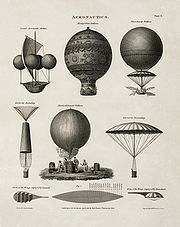
Hot air balloon
The hot air balloon is the oldest successful human-carrying flight technology. It is in a class of aircraft known as balloon aircraft. On November 21, 1783, in Paris, France, the first untethered manned flight was made by Jean-François Pilâtre de Rozier and François Laurent d'Arlandes in a hot air...
and gas
Gas balloon
A gas balloon is any balloon that stays aloft due to being filled with a gas less dense than air or lighter than air . A gas balloon may also be called a Charlière for its inventor, the Frenchman Jacques Charles. Today, familiar gas balloons include large blimps and small rubber party balloons...
, spans many centuries. It includes many firsts, including the first human flight, first flight across the English Channel, first flight in North America, and first aircraft related disaster.
Premodern and unmanned balloons

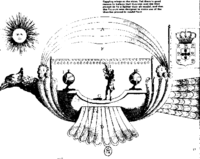
China
Chinese civilization may refer to:* China for more general discussion of the country.* Chinese culture* Greater China, the transnational community of ethnic Chinese.* History of China* Sinosphere, the area historically affected by Chinese culture...
history. Zhuge Liang
Zhuge Liang
Zhuge Liang was a chancellor of the state of Shu Han during the Three Kingdoms period of Chinese history. He is often recognised as the greatest and most accomplished strategist of his era....
of the Shu Han
Shu Han
Shu Han was one of the three states competing for control of China during the Three Kingdoms period, after the fall of the Han Dynasty. The state was based on areas around Sichuan, which was then known as Shu...
kingdom, in the Three Kingdoms
Three Kingdoms
The Three Kingdoms period was a period in Chinese history, part of an era of disunity called the "Six Dynasties" following immediately the loss of de facto power of the Han Dynasty rulers. In a strict academic sense it refers to the period between the foundation of the state of Wei in 220 and the...
era (220-280 AD) used airborne lanterns for military signaling. These lanterns are known as Kongming lanterns (孔明灯).
There is also some speculation, from a demonstration led by British modern hot air balloonist Julian Nott
Julian Nott (balloonist)
Julian Nott is a British balloonist who now lives in Santa Barbara, CA, USA. He is known for his achievements in record-setting exploits. Nott has set 79 World ballooning Records and 96 British aviation records. He is currently actively involved in developing balloons for flights at Solar System...
in the late 1970s and again in 2003, that hot air balloons could have been used by people of the Nazca culture
Nazca culture
The Nazca culture was the archaeological culture that flourished from 100 to 800 CE beside the dry southern coast of Peru in the river valleys of the Rio Grande de Nazca drainage and the Ica Valley...
of Peru
Peru
Peru , officially the Republic of Peru , is a country in western South America. It is bordered on the north by Ecuador and Colombia, on the east by Brazil, on the southeast by Bolivia, on the south by Chile, and on the west by the Pacific Ocean....
some 1500 to 2000 years ago, as a tool for designing the famous Nazca ground figures and lines
Nazca Lines
The Nazca Lines are a series of ancient geoglyphs located in the Nazca Desert in southern Peru. They were designated a UNESCO World Heritage Site in 1994. The high, arid plateau stretches more than between the towns of Nazca and Palpa on the Pampas de Jumana about 400 km south of Lima...
.
The first documented balloon flight in Europe was by the Portuguese
Portuguese people
The Portuguese are a nation and ethnic group native to the country of Portugal, in the west of the Iberian peninsula of south-west Europe. Their language is Portuguese, and Roman Catholicism is the predominant religion....
priest Bartolomeu de Gusmão
Bartolomeu de Gusmão
Bartolomeu Lourenço de Gusmão , was a priest and naturalist born in the then Portuguese colony of Brazil, noted for his early work on lighter-than-air airship design....
. On August 8, 1709, in Lisbon
Lisbon
Lisbon is the capital city and largest city of Portugal with a population of 545,245 within its administrative limits on a land area of . The urban area of Lisbon extends beyond the administrative city limits with a population of 3 million on an area of , making it the 9th most populous urban...
, Bartolomeu de Gusmão
Bartolomeu de Gusmão
Bartolomeu Lourenço de Gusmão , was a priest and naturalist born in the then Portuguese colony of Brazil, noted for his early work on lighter-than-air airship design....
managed to lift a small balloon made of paper full of hot air about four meters in front of king John V and the Portuguese
Portuguese people
The Portuguese are a nation and ethnic group native to the country of Portugal, in the west of the Iberian peninsula of south-west Europe. Their language is Portuguese, and Roman Catholicism is the predominant religion....
court. According to the Portuguese speaking community, this was the first man ever to fly in human history. However, this claim is not generally recognized by aviation historians outside the Portuguese speaking community, in particular the FAI
Fédération Aéronautique Internationale
The Fédération Aéronautique Internationale is the world governing body for air sports and aeronautics and astronautics world records. Its head office is in Lausanne, Switzerland. This includes man-carrying aerospace vehicles from balloons to spacecraft, and unmanned aerial vehicles...
.
First hydrogen balloon
Following Henry CavendishHenry Cavendish
Henry Cavendish FRS was a British scientist noted for his discovery of hydrogen or what he called "inflammable air". He described the density of inflammable air, which formed water on combustion, in a 1766 paper "On Factitious Airs". Antoine Lavoisier later reproduced Cavendish's experiment and...
's 1766 work on hydrogen
Hydrogen
Hydrogen is the chemical element with atomic number 1. It is represented by the symbol H. With an average atomic weight of , hydrogen is the lightest and most abundant chemical element, constituting roughly 75% of the Universe's chemical elemental mass. Stars in the main sequence are mainly...
, and Robert Boyle
Robert Boyle
Robert Boyle FRS was a 17th century natural philosopher, chemist, physicist, and inventor, also noted for his writings in theology. He has been variously described as English, Irish, or Anglo-Irish, his father having come to Ireland from England during the time of the English plantations of...
's Boyle's Law
Boyle's law
Boyle's law is one of many gas laws and a special case of the ideal gas law. Boyle's law describes the inversely proportional relationship between the absolute pressure and volume of a gas, if the temperature is kept constant within a closed system...
which was published 100 years earlier in 1662, Joseph Black
Joseph Black
Joseph Black FRSE FRCPE FPSG was a Scottish physician and chemist, known for his discoveries of latent heat, specific heat, and carbon dioxide. He was professor of Medicine at University of Glasgow . James Watt, who was appointed as philosophical instrument maker at the same university...
proposed that a balloon filled with hydrogen would be able to rise in the air. Professor Jacques Charles
Jacques Charles
Jacques Alexandre César Charles was a French inventor, scientist, mathematician, and balloonist.Charles and the Robert brothers launched the world's first hydrogen-filled balloon in August 1783, then in December 1783, Charles and his co-pilot Nicolas-Louis Robert ascended to a height of about...
, having studied the work of Cavendish, Black and Tiberius Cavallo
Tiberius Cavallo
Tiberius Cavallo was an Italian physicist and natural philosopher.-Life:He was born at Naples, where his father was a physician....
, conceived the idea that hydrogen would be a suitable lifting agent for balloons.
Jacques Charles designed the hydrogen balloon, and the Robert brothers
Robert brothers
Les Frères Robert were two French brothers. Anne-Jean Robert , and Nicolas-Louis Robert , The brothers were the engineers who built the world's first hydrogen balloon for professor Jacques Charles; it flew from central Paris on...
invented the methodology for constructing the lightweight, airtight gas bag. They dissolved rubber
Rubber
Natural rubber, also called India rubber or caoutchouc, is an elastomer that was originally derived from latex, a milky colloid produced by some plants. The plants would be ‘tapped’, that is, an incision made into the bark of the tree and the sticky, milk colored latex sap collected and refined...
in a solution of turpentine
Turpentine
Turpentine is a fluid obtained by the distillation of resin obtained from trees, mainly pine trees. It is composed of terpenes, mainly the monoterpenes alpha-pinene and beta-pinene...
and varnish
Varnish
Varnish is a transparent, hard, protective finish or film primarily used in wood finishing but also for other materials. Varnish is traditionally a combination of a drying oil, a resin, and a thinner or solvent. Varnish finishes are usually glossy but may be designed to produce satin or semi-gloss...
ed the sheets of silk
Silk
Silk is a natural protein fiber, some forms of which can be woven into textiles. The best-known type of silk is obtained from the cocoons of the larvae of the mulberry silkworm Bombyx mori reared in captivity...
that were stitched together to make the main envelope. They used alternate strips of red and white silk, but the discolouration of the varnishing/rubberising process left a red and yellow result.
Jacques Charles and the Robert brothers launched their balloon, the world's first hydrogen
Hydrogen
Hydrogen is the chemical element with atomic number 1. It is represented by the symbol H. With an average atomic weight of , hydrogen is the lightest and most abundant chemical element, constituting roughly 75% of the Universe's chemical elemental mass. Stars in the main sequence are mainly...
-filled balloon
Balloon
A balloon is an inflatable flexible bag filled with a gas, such as helium, hydrogen, nitrous oxide, oxygen, or air. Modern balloons can be made from materials such as rubber, latex, polychloroprene, or a nylon fabric, while some early balloons were made of dried animal bladders, such as the pig...
, on August 27, 1783, from the Champ de Mars
Champ de Mars
The Champ de Mars is a large public greenspace in Paris, France, located in the seventh arrondissement, between the Eiffel Tower to the northwest and the École Militaire to the southeast. The park is named after the Campus Martius in Rome, a tribute to the Roman god of war...
(now the site of the Eiffel Tower
Eiffel Tower
The Eiffel Tower is a puddle iron lattice tower located on the Champ de Mars in Paris. Built in 1889, it has become both a global icon of France and one of the most recognizable structures in the world...
); Benjamin Franklin
Benjamin Franklin
Dr. Benjamin Franklin was one of the Founding Fathers of the United States. A noted polymath, Franklin was a leading author, printer, political theorist, politician, postmaster, scientist, musician, inventor, satirist, civic activist, statesman, and diplomat...
was among the crowd of onlookers. The balloon was comparatively small, a 35 cubic metre sphere of rubberised silk, and only capable of lifting about 9 kg. It was filled with hydrogen that had been made by pouring nearly a quarter of a tonne of sulphuric acid onto half a tonne of scrap iron. The hydrogen gas was fed into the envelope via lead
Lead
Lead is a main-group element in the carbon group with the symbol Pb and atomic number 82. Lead is a soft, malleable poor metal. It is also counted as one of the heavy metals. Metallic lead has a bluish-white color after being freshly cut, but it soon tarnishes to a dull grayish color when exposed...
pipes; but as it was not passed through cold water, great difficulty was experienced in filling the balloon completely (the gas was hot when produced, but as it cooled in the balloon, it contracted). Daily progress bulletins were issued on the inflation; and the crowd was so great that on the 26th the balloon was moved secretly by night to the Champ de Mars, a distance of 4 kilometres.
The balloon flew northwards for 45 minutes, pursued by chasers on horseback, and landed 21 kilometres away in the village of Gonesse
Gonesse
Gonesse is a commune in the northeastern suburbs of Paris, France. It is located from the centre of Paris.The commune lies immediately north of Le Bourget Airport and southwest of Charles de Gaulle International Airport.-History:...
where the reportedly terrified local peasants attacked it with pitchforks or knives and destroyed it. The project was funded by a subscription organised by Barthélémy Faujas de Saint-Fond
Barthélemy Faujas de Saint-Fond
Barthélemy Faujas de Saint-Fond , French geologist and traveller, was born at Montélimar. He was educated at the Jesuit's College at Lyon; afterwards he went to Grenoble where he studied law and was admitted as an advocate to the parlement.He rose to be president of the seneschal's court in...
.
First unmanned flight
On 19 September 1783, the Montgolfier brothersMontgolfier brothers
Joseph-Michel Montgolfier and Jacques-Étienne Montgolfier were the inventors of the montgolfière-style hot air balloon, globe aérostatique. The brothers succeeded in launching the first manned ascent, carrying Étienne into the sky...
' balloon Aerostat Réveillon was flown with the first living beings in a basket attached to the balloon: a sheep called Montauciel ("Climb-to-the-sky"), a duck
Duck
Duck is the common name for a large number of species in the Anatidae family of birds, which also includes swans and geese. The ducks are divided among several subfamilies in the Anatidae family; they do not represent a monophyletic group but a form taxon, since swans and geese are not considered...
and a rooster
Rooster
A rooster, also known as a cockerel, cock or chanticleer, is a male chicken with the female being called a hen. Immature male chickens of less than a year's age are called cockerels...
. The sheep was believed to have a reasonable approximation of human physiology
Human physiology
Human physiology is the science of the mechanical, physical, bioelectrical, and biochemical functions of humans in good health, their organs, and the cells of which they are composed. Physiology focuses principally at the level of organs and systems...
. The duck was expected to be unharmed by being lifted aloft. It was included as a control for effects created by the aircraft rather than the altitude. The rooster was included as a further control as it was a bird that did not fly at high altitudes. This demonstration was performed before a crowd at the royal palace in Versailles, before King Louis XVI of France
Louis XVI of France
Louis XVI was a Bourbon monarch who ruled as King of France and Navarre until 1791, and then as King of the French from 1791 to 1792, before being executed in 1793....
and Queen Marie Antoinette
Marie Antoinette
Marie Antoinette ; 2 November 1755 – 16 October 1793) was an Archduchess of Austria and the Queen of France and of Navarre. She was the fifteenth and penultimate child of Holy Roman Empress Maria Theresa and Holy Roman Emperor Francis I....
. The flight lasted approximately eight minutes, covered two miles (3 km), and obtained an altitude of about 1,500 feet (460 m). The craft landed safely after flying.
First manned flight
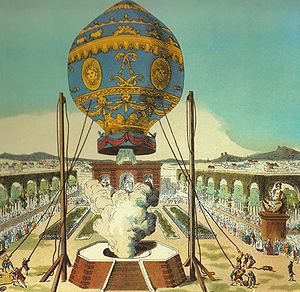
Buoyancy
In physics, buoyancy is a force exerted by a fluid that opposes an object's weight. In a column of fluid, pressure increases with depth as a result of the weight of the overlying fluid. Thus a column of fluid, or an object submerged in the fluid, experiences greater pressure at the bottom of the...
and was built by the brothers Joseph-Michel and Jacques-Etienne Montgolfier
Montgolfier brothers
Joseph-Michel Montgolfier and Jacques-Étienne Montgolfier were the inventors of the montgolfière-style hot air balloon, globe aérostatique. The brothers succeeded in launching the first manned ascent, carrying Étienne into the sky...
in Annonay, France. These brothers came from a family of paper manufacturers and had noticed ash rising in paper fires. The Montgolfier brothers gave their first public demonstration of their invention on June 4, 1783. After experimenting with unmanned balloons and flights with animals, the first tethered balloon flight with humans on board took place on October 19, 1783 with the scientist Jean-François Pilâtre de Rozier, the manufacture manager, Jean-Baptiste Réveillon
Jean-Baptiste Réveillon
Jean-Baptiste Réveillon, was a French wallpaper manufacturer. Réveillon's career was an exemplary story of the self-made businessman.-Life:...
and Giroud de Villette, at the Folie Titon in Paris. The first free flight with human passengers was on 21 November 1783. King Louis XVI
Louis XVI of France
Louis XVI was a Bourbon monarch who ruled as King of France and Navarre until 1791, and then as King of the French from 1791 to 1792, before being executed in 1793....
had originally decreed that condemned criminals would be the first pilots
Aviator
An aviator is a person who flies an aircraft. The first recorded use of the term was in 1887, as a variation of 'aviation', from the Latin avis , coined in 1863 by G. de la Landelle in Aviation Ou Navigation Aérienne...
, but de Rozier, along with the Marquis François d'Arlandes
François Laurent d'Arlandes
François Laurent le Vieux d'Arlandes was a French marquis, soldier and a pioneer of hot air ballooning. He and Jean-François Pilâtre de Rozier made the first manned free balloon flight on 21 November 1783, in a Montgolfier balloon....
, successfully petitioned for the honor. The first hot air balloons were essentially cloth bags (sometimes lined with paper) with a smoky fire built on a grill attached to the bottom. They were susceptible to catching fire, often upon landing, although this occurred infrequently. The pioneering work of the Montgolfier brothers in developing the hot air balloon was recognised by this type of balloon being named Montgolfière after them.
First manned hydrogen balloon flight
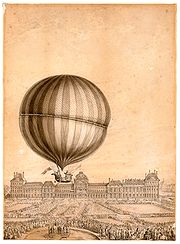
Jacques Charles
Jacques Alexandre César Charles was a French inventor, scientist, mathematician, and balloonist.Charles and the Robert brothers launched the world's first hydrogen-filled balloon in August 1783, then in December 1783, Charles and his co-pilot Nicolas-Louis Robert ascended to a height of about...
and the Robert brothers
Robert brothers
Les Frères Robert were two French brothers. Anne-Jean Robert , and Nicolas-Louis Robert , The brothers were the engineers who built the world's first hydrogen balloon for professor Jacques Charles; it flew from central Paris on...
(Les Frères Robert) launched a new, manned hydrogen balloon from the Jardin des Tuileries
Tuileries Palace
The Tuileries Palace was a royal palace in Paris which stood on the right bank of the River Seine until 1871, when it was destroyed in the upheaval during the suppression of the Paris Commune...
in Paris, amid vast crowds and excitement. The balloon was held on ropes and led to its final launch place by four of the leading noblemen in France, the Marechal de Richelieu
Louis Antoine Sophie de Vignerot du Plessis
Louis Antoine Sophie de Vignerot du Plessis , duke of Fronsac, then duke of Richelieu , prince de Mortagne, marquis du Pont-Courlay, comte de Cosnac, baron de Barbezieux, baron de Coze et baron de Saugeon, was a French nobleman and general.-Life:He was the son of Louis François Armand de Vignerot...
, Marshal de Biron
Louis Antoine de Gontaut
Louis Antoine de Gontaut-Biron, duc de Biron was Duke of Biron and a French military leader who served with distinction under Louis XV, and was made a Marshal of France in 1757....
, the Bailiff of Suffren, and the Duke of Chaulnes
Louis Joseph d'Albert d'Ailly
Louis Joseph d'Albert d'Ailly , seventh Duke of Chaulnes and son of Michel Ferdinand d'Albert d'Ailly, was a chemist and French aristocrat.-Biography:At the death of his father in 1769, Louis Joseph inherited the title of Duke of Picquigny...
. Jacques Charles was accompanied by Nicolas-Louis Robert as co-pilot of the 380-cubic-metre, hydrogen-filled balloon. The envelope was fitted with a hydrogen release valve, and was covered with a net from which the basket was suspended. Sand ballast was used to control altitude. They ascended to a height of about 1,800 feet (550 m) and landed at sunset in Nesles-la-Vallée
Nesles-la-Vallée
Nesles-la-Vallée is a commune in the Val-d'Oise department in Île-de-France in northern France.-References:** -External links:* *...
after a flight of 2 hours and 5 minutes, covering 36 km. The chasers on horseback, who were led by the Duc de Chartres, held down the craft while both Charles and Robert alighted.
Charles then decided to ascend again, but alone this time because the balloon had lost some of its hydrogen. This time he ascended rapidly to an altitude of about 3,000 metres), where he saw the sun again. He began suffering from aching pain in his ears so he 'valved' to release gas, and descended to land gently about 3 km away at Tour du Lay. Unlike the Robert brothers, Charles never flew again, although a balloon using hydrogen for its lift came to be called a Charlière in his honour.
Charles and Robert carried a barometer and a thermometer to measure the pressure and the temperature of the air, making this not only the first manned hydrogen balloon flight, but also the first balloon flight to provide meteorological measurements of the atmosphere above the Earth's surface.
It is reported that 400,000 spectators witnessed the launch, and that hundreds had paid one crown each to help finance the construction and receive access to a 'special enclosure' for a "close-up view" of the take-off. Among the 'special enclosure' crowd was Benjamin Franklin
Benjamin Franklin
Dr. Benjamin Franklin was one of the Founding Fathers of the United States. A noted polymath, Franklin was a leading author, printer, political theorist, politician, postmaster, scientist, musician, inventor, satirist, civic activist, statesman, and diplomat...
, the diplomatic representative of the United States of America. Also present was Joseph Montgolfier, whom Charles honoured by asking him to release the small, bright green, pilot balloon to assess the wind and weather conditions.
Further milestones
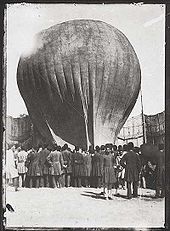
English Channel
The English Channel , often referred to simply as the Channel, is an arm of the Atlantic Ocean that separates southern England from northern France, and joins the North Sea to the Atlantic. It is about long and varies in width from at its widest to in the Strait of Dover...
, a feat accomplished on January 7, 1785 by Jean-Pierre Blanchard
Jean-Pierre Blanchard
Jean-Pierre Blanchard , aka Jean Pierre François Blanchard, was a French inventor, most remembered as a pioneer in aviation and ballooning....
.
The first aircraft disaster occurred in May 1785 when the town of Tullamore
Tullamore
Tullamore is a town in County Offaly, in the midlands of Ireland. It is Offaly's county town and the centre of the district.Tullamore is an important commercial and industrial centre in the region. Major international employers in the town include 'Tyco Healthcare' and 'Boston Scientific'. In...
, County Offaly
County Offaly
County Offaly is a county in Ireland. It is part of the Midlands Region and is also located in the province of Leinster. It is named after the ancient Kingdom of Uí Failghe and was formerly known as King's County until the establishment of the Irish Free State in 1922. Offaly County Council is...
, Ireland
Ireland
Ireland is an island to the northwest of continental Europe. It is the third-largest island in Europe and the twentieth-largest island on Earth...
was seriously damaged when the crash of a balloon resulted in a fire that burned down about 100 houses, making the town home to the world's first aviation disaster
Aviation accidents and incidents
An aviation accident is defined in the Convention on International Civil Aviation Annex 13 as an occurrence associated with the operation of an aircraft which takes place between the time any person boards the aircraft with the intention of flight and all such persons have disembarked, in which a...
. To this day, the town shield depicts a phoenix
Phoenix (mythology)
The phoenix or phenix is a mythical sacred firebird that can be found in the mythologies of the Arabian, Persians, Greeks, Romans, Egyptians, Chinese, Indian and Phoenicians....
rising from the ashes.
Blanchard went on to make the first manned flight of a balloon in America on January 10, 1793. His hydrogen-filled balloon took off from a prison yard in Philadelphia, Pennsylvania
Philadelphia, Pennsylvania
Philadelphia is the largest city in the Commonwealth of Pennsylvania and the county seat of Philadelphia County, with which it is coterminous. The city is located in the Northeastern United States along the Delaware and Schuylkill rivers. It is the fifth-most-populous city in the United States,...
. The flight reached 5,800 feet (1,770 m) and landed in Gloucester County, New Jersey
Gloucester County, New Jersey
Gloucester County is a county located in the U.S. state of New Jersey. As of the 2010 Census, the population was 288,288. Its county seat is Woodbury....
. President George Washington
George Washington
George Washington was the dominant military and political leader of the new United States of America from 1775 to 1799. He led the American victory over Great Britain in the American Revolutionary War as commander-in-chief of the Continental Army from 1775 to 1783, and presided over the writing of...
was among the guests observing the takeoff.
Gas balloons became the most common type from the 1790s until the 1960s.
The first steerable balloon (also known as a dirigible
Airship
An airship or dirigible is a type of aerostat or "lighter-than-air aircraft" that can be steered and propelled through the air using rudders and propellers or other thrust mechanisms...
) was flown by Henri Giffard
Henri Giffard
Henri Giffard was a French engineer. In 1852 he invented the steam injector and the powered airship.-Career:Baptiste Henri Jacques Giffard was born in Paris in 1825...
in 1852. Powered by a steam engine
Steam engine
A steam engine is a heat engine that performs mechanical work using steam as its working fluid.Steam engines are external combustion engines, where the working fluid is separate from the combustion products. Non-combustion heat sources such as solar power, nuclear power or geothermal energy may be...
, it was too slow to be effective. Like heavier than air flight, the internal combustion engine
Internal combustion engine
The internal combustion engine is an engine in which the combustion of a fuel occurs with an oxidizer in a combustion chamber. In an internal combustion engine, the expansion of the high-temperature and high -pressure gases produced by combustion apply direct force to some component of the engine...
made dirigibles—especially blimps—practical, starting in the late 19th century. In 1872 Paul Haenlein
Paul Haenlein
Paul Haenlein was a German engineer and flight pioneer. He flew in a semi-rigid-frame dirigible. His family belonged to the Citoyens notables, those notabilities who led the economy, administration and culture of Mainz.Haenlein received an education as a mechanical engineer and pattern maker...
flew the first (tethered) internal combustion motor-powered balloon. The first to fly in an untethered airship powered by an internal combustion engine was Alberto Santos Dumont in 1898.
Henri Giffard
Henri Giffard
Henri Giffard was a French engineer. In 1852 he invented the steam injector and the powered airship.-Career:Baptiste Henri Jacques Giffard was born in Paris in 1825...
also developed a tethered balloon for passengers in 1878 in the Tuileries Garden in Paris.
| Events in the early history of ballooning; collecting cards from the late 19th century. |
Ballooning in England
The first attempt at ballooning in England was by Signor Vincent Lunardi who ascended from Moorfields (London) in 15 September 1784.Jean-Pierre Blanchard
Jean-Pierre Blanchard
Jean-Pierre Blanchard , aka Jean Pierre François Blanchard, was a French inventor, most remembered as a pioneer in aviation and ballooning....
and Jeffries flew from Dover to Calais in 1785.
In the same year, a Mr Arnold went up from St Georges Fields (London), but came down in the River Thames, and a Major John Money (1752–1817) took off from Norwich, in an attempt to raise money for the Norfolk and Norwich Hospital. He passed over Lowestoft at 6pm and came down about 18 miles (29 km) into the North Sea and was saved by a revenue cutter about five hours later.
The first ascent in Ireland was from Ranaleigh Gardens in Dublin in 1785.
James Sadler
James Sadler (balloonist)
James Sadler was the first English balloonist.Sadler was the second person to make a balloon ascent in England, very soon after the Tuscan Vincent Lunardi's flight on 15 September 1784 in the grounds of the Honourable Artillery Company at Moorfields. Sadler made his ascent during the month after...
made many flights in England, but on 9 October 1812 he came down in the sea and was rescued near Holyhead. His son, Windham Sadler was killed when he fell from a balloon in 1825. Lieutenant Harris was killed falling from a balloon on 25 May 1824.
Charles Green
Charles Green (balloonist)
Charles Green was the United Kingdom's most famous balloonist of the 19th century. He experimented with coal gas as a cheaper and more readily available alternative to hydrogen for lifting power. His first ascent was in a coal gas balloon on 19 July 1821. He became a professional balloonist and...
and others made a number of ascents in London between 1821 and 1852. His first ascent was on July 19, 1821. He claimed that in May 1828 he actually took his horse up with him but this was disputed, and the public had to wait until July 1850 when he lifted off from Vauxhall Gardens with a somewhat diminutive pony as his "steed". Further attempts were made in France until Madame Poitevin took off from Cremorne Gardens in London in August 1852, as "Europa on a Bull" (the bull dressed as rather a nervous "Zeus") but this led to a charge of cruelty to animals, a police case, a diplomatic dilemma and general public outrage after which no animals were used.
In 1836, the “Royal Vauxhall” balloon which was used as a pleasure balloon in Vauxhall Gardens
Vauxhall Gardens
Vauxhall Gardens was a pleasure garden, one of the leading venues for public entertainment in London, England from the mid 17th century to the mid 19th century. Originally known as New Spring Gardens, the site was believed to have opened before the Restoration of 1660 with the first mention being...
was used by Charles Green
Charles Green (balloonist)
Charles Green was the United Kingdom's most famous balloonist of the 19th century. He experimented with coal gas as a cheaper and more readily available alternative to hydrogen for lifting power. His first ascent was in a coal gas balloon on 19 July 1821. He became a professional balloonist and...
with two crew and after 18 hours came down safely at Weilburg in the German Duchy of Nassau, setting a record unbeaten till 1907
Robert Cocking
Robert Cocking
Robert Cocking was the developer of an early unsuccessful parachute design and the first person to be killed in a parachuting accident.-Parachute design:...
, an artist, devised a parachute based upon Garnerin
André-Jacques Garnerin
André-Jacques Garnerin was the inventor of the frameless parachute. He was born in Paris.His early experiments were based on umbrella-shaped devices...
’s prototype (in which he had great faith) and ascended in a balloon from Vauxhall (London) on 24 July 1837 to about 1500m. The parachute failed to open properly and Cocking was killed.
Military use
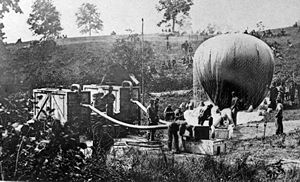
Aircraft
An aircraft is a vehicle that is able to fly by gaining support from the air, or, in general, the atmosphere of a planet. An aircraft counters the force of gravity by using either static lift or by using the dynamic lift of an airfoil, or in a few cases the downward thrust from jet engines.Although...
in Europe
Europe
Europe is, by convention, one of the world's seven continents. Comprising the westernmost peninsula of Eurasia, Europe is generally 'divided' from Asia to its east by the watershed divides of the Ural and Caucasus Mountains, the Ural River, the Caspian and Black Seas, and the waterways connecting...
took place during the French Revolutionary Wars
French Revolutionary Wars
The French Revolutionary Wars were a series of major conflicts, from 1792 until 1802, fought between the French Revolutionary government and several European states...
, when the French used a tethered hydrogen
Hydrogen
Hydrogen is the chemical element with atomic number 1. It is represented by the symbol H. With an average atomic weight of , hydrogen is the lightest and most abundant chemical element, constituting roughly 75% of the Universe's chemical elemental mass. Stars in the main sequence are mainly...
balloon to observe the movements of the Austrian army during the Battle of Fleurus (1794)
Battle of Fleurus (1794)
In the Battle of Fleurus on 26 June 1794, the army of the First French Republic under General Jean-Baptiste Jourdan faced the Coalition Army commanded by Prince Josias of Coburg in the most decisive battle of the Flanders Campaign in the Low Countries during the French Revolutionary Wars...
.
In 1811 Franz Leppich went to Napoleon and claimed that he could build a hydrogen balloon that would enable the French to attack from the air. Napoleon then ordered that he be removed from French Territory. In 1812 the secret service from Russia got Leppich Passports with the name Schmidt and then he and a secret undercover person went to Moscow to Count Rostopchin
Fyodor Rostopchin
Count Fyodor Vasilyevich Rostopchin was a Russian statesman, who served as governor of Moscow during French invasion of Russia.Rostopchin was born in Orel, son of Vasily Fyodorovich Rostopchin, Lord of Livna and ... Krakova...
. Near Moscow a "Werft" was set up and with about 50 other German-speaking mechanics, and he started to build "air bouts". When the balloon was finally tried out, they worked but were unable to move against the wind . Leppich did final work after the burning of Moscow, on this about a year longer near St. Petersburg and then he left for Germany again. There he worked on the subject up to 1817. In 1818 he received a patent in his and his brothers name in Vienna for making nails with a punch .
In Tolstoy
Tolstoy
Tolstoy, or Tolstoi is a prominent family of Russian nobility, descending from Andrey Kharitonovich Tolstoy who served under Vasily II of Moscow...
's novel, War and Peace
War and Peace
War and Peace is a novel by the Russian author Leo Tolstoy, first published in 1869. The work is epic in scale and is regarded as one of the most important works of world literature...
, Count Pyótr Kiríllovich Bezúkhov (Pierre) makes an excursion to see this balloon though he does not see it. Tolstoy also includes a letter from the sovereign Emperor Alexander I to Count Rostopchin concerning the balloon.

American Civil War
The American Civil War was a civil war fought in the United States of America. In response to the election of Abraham Lincoln as President of the United States, 11 southern slave states declared their secession from the United States and formed the Confederate States of America ; the other 25...
. The military balloons used by the Union Army Balloon Corps
Union Army Balloon Corps
The Union Army Balloon Corps was a branch of the Union Army during the American Civil War, established by presidential appointee Thaddeus S. C. Lowe...
under the command of Prof. Thaddeus S. C. Lowe
Thaddeus S. C. Lowe
Thaddeus Sobieski Coulincourt Lowe , also known as Professor T. S. C. Lowe, was an American Civil War aeronaut, scientist and inventor, mostly self-educated in the fields of chemistry, meteorology, and aeronautics, and the father of military aerial reconnaissance in the United States...
were limp silk envelopes inflated with coal gas (town gas) or hydrogen.
Twentieth century
During World War II, a large number of Barrage BalloonBarrage balloon
A barrage balloon is a large balloon tethered with metal cables, used to defend against low-level aircraft attack by damaging the aircraft on collision with the cables, or at least making the attacker's approach more difficult. Some versions carried small explosive charges that would be pulled up...
s were inflated over the city of London in an effort to obstruct Luftwaffe air attacks during the Battle of Britain
Battle of Britain
The Battle of Britain is the name given to the World War II air campaign waged by the German Air Force against the United Kingdom during the summer and autumn of 1940...
. Whatever their effectiveness, they were a cheap defense but did not stop heavy damage inflicted on Londoners during the Blitz
The Blitz
The Blitz was the sustained strategic bombing of Britain by Nazi Germany between 7 September 1940 and 10 May 1941, during the Second World War. The city of London was bombed by the Luftwaffe for 76 consecutive nights and many towns and cities across the country followed...
, probably because the Heinkel He 111
Heinkel He 111
The Heinkel He 111 was a German aircraft designed by Siegfried and Walter Günter in the early 1930s in violation of the Treaty of Versailles. Often described as a "Wolf in sheep's clothing", it masqueraded as a transport aircraft, but its purpose was to provide the Luftwaffe with a fast medium...
bombers flew too high. Nonetheless, some 231 V1 rockets were destroyed.
In the early and mid-20th century, hydrogen balloons were used extensively in upper-atmosphere research in such projects as Osoaviakhim-1
Osoaviakhim-1
Osoaviakhim-1 was a record-setting, hydrogen-filled Soviet high-altitude balloon designed to seat a crew of three and perform scientific studies of the Earth's stratosphere. On January 30, 1934, on its maiden flight which lasted over 7 hours, the balloon reached an altitude of...
, the Stratobowl
Stratobowl
The Stratobowl is a compact natural depression within the limits of Black Hills National Forest in South Dakota, south-west of Rapid City. In 1934–1935 it housed a stratospheric balloon launch site, initially known as Stratocamp, sponsored by the National Geographic Society and the United States...
launches, Project Manhigh
Project Manhigh
Project Manhigh along with Project Excelsior was a pre-Space Age military project that took men in balloons to the middle layers of the Earth’s stratosphere.-History:...
, and Project Strato-Lab. A series of ascensions set a number of high-altitude records before space flight eclipsed ballooning as an endeavor. When governments lost interest in manned balloons, private citizens continued to strive to set records, especially for long distances, and to achieve "first" marks (such as Double Eagle II
Double Eagle II
Double Eagle II, piloted by Ben Abruzzo, Maxie Anderson, and Larry Newman, became the first balloon to cross the Atlantic Ocean when it landed 17 August 1978 in Miserey near Paris, 137 hours 6 minutes after leaving Presque Isle, Maine....
(first to cross the Atlantic Ocean) and Breitling Orbiter 3 (first to circumnavigate the world).
Although manned high-altitude balloon ascensions are still undertaken, they are more likely to be the work of adventurers than researchers.
Modern day
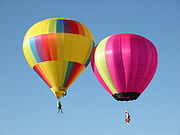
Ed Yost
Paul Edward Yost was the American inventor of the modern hot air balloon and is referred to as the "Father of the Modern Day Hot-Air Balloon." He worked for a high altitude research division of General Mills when he helped establish Raven Industries in 1956.-Inventor:Born on a farm 7 miles...
beginning in the 1950s which resulted in his first successful flight on October 22, 1960. The first modern day hot air balloon to be built in the United Kingdom
United Kingdom
The United Kingdom of Great Britain and Northern IrelandIn the United Kingdom and Dependencies, other languages have been officially recognised as legitimate autochthonous languages under the European Charter for Regional or Minority Languages...
(UK) was the Bristol Belle
Bristol Belle
The Bristol Belle was the name given to the first modern hot air balloon in Britain.. The balloon was created from an idea developed by members of the Bristol , UK Gliding Club. Following developments by Ed Yost in the United States, members of the Bristol Gliding Club decided to create their own...
in 1967. Today, hot air balloons are used primarily for recreation, and there are some 7,500 hot air balloons operating in the United States
United States
The United States of America is a federal constitutional republic comprising fifty states and a federal district...
.
The first tethered balloon in modern times was made in France at Chantilly Castle in 1994 by Aérophile SA
Aerophile SA
Aerophile SA is a French company specializing in tethered helium balloons, which offer a safe aerial experience from a fixed location.- History :...
.
External links
- NOTABLE PERFORMANCES and ACHIEVEMENTS
- History of Ballooning (Student Essay) - Student Essay on History of Ballooning
- Video of The Double Eagle Balloon after crossing the Atlantic Ocean
- British film Conquest of the Air starring Laurence Olivier stars as Vincent Lunardi

